Sensory Marketing and International Consumer Behavior Analysis
VerifiedAdded on 2023/06/12
|13
|3494
|195
Report
AI Summary
This report examines the impact of sensory marketing on international consumer behavior, particularly focusing on how techniques like South Korean-developed 4DX cinema influence consumers' willingness to pay. It reviews existing literature, highlighting how sensory marketing leverages sight, sound, touch, smell, and taste to create immersive brand experiences and foster customer loyalty. The report discusses the ethical considerations of sense manipulation and its potential impact on sales and consumer sentiment. Findings from secondary research suggest that sensory marketing, exemplified by virtual tourism in Hawaii and the use of 4D technology, enhances customer engagement and willingness to pay. The study concludes that successful sensory marketing strategies require a deep understanding of consumer psychology and the careful integration of sensory elements to create memorable and positive brand associations. The report also emphasizes the importance of adapting strategies to overcome cultural barriers and create shared experiences.
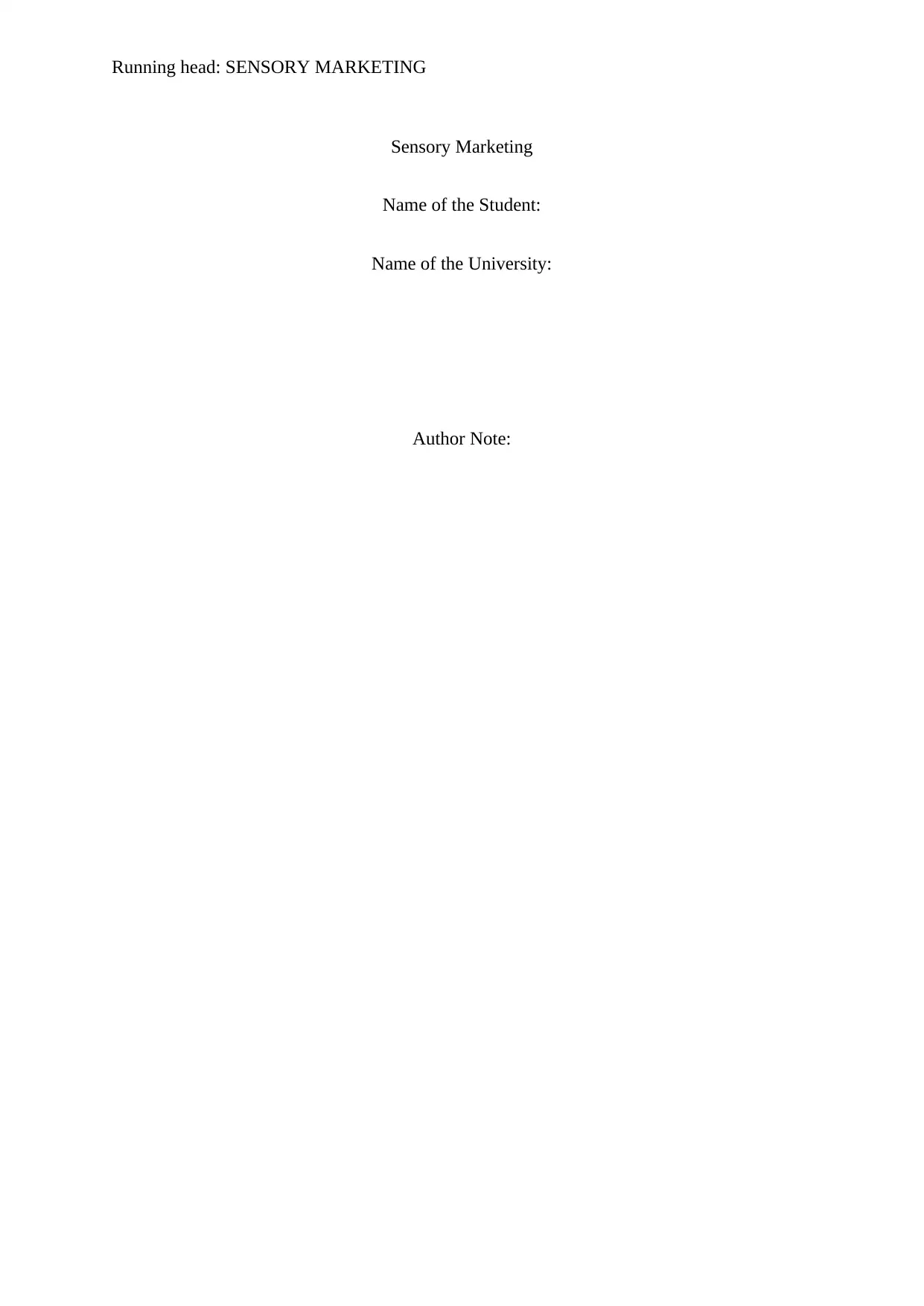
Running head: SENSORY MARKETING
Sensory Marketing
Name of the Student:
Name of the University:
Author Note:
Sensory Marketing
Name of the Student:
Name of the University:
Author Note:
Paraphrase This Document
Need a fresh take? Get an instant paraphrase of this document with our AI Paraphraser
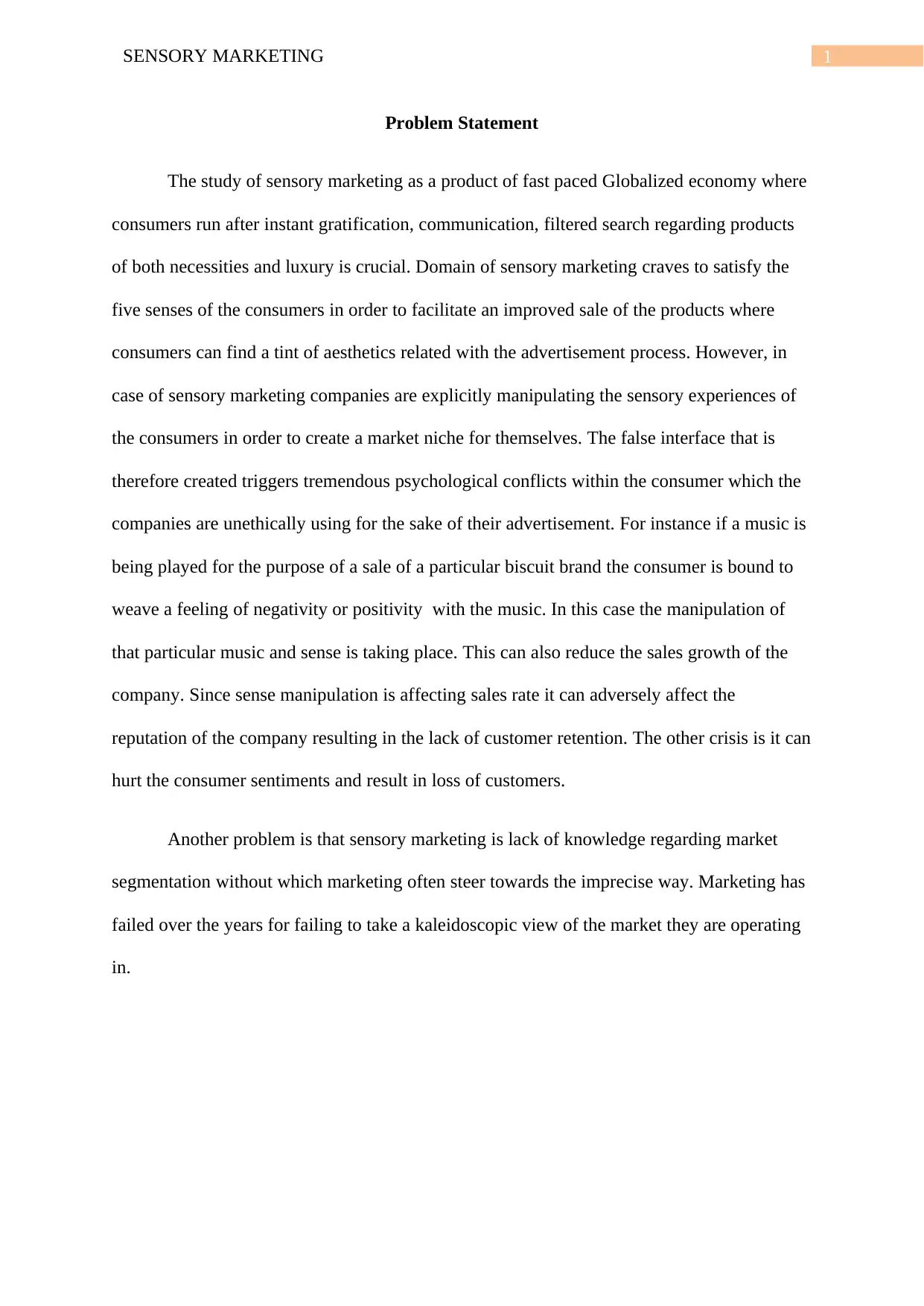
1SENSORY MARKETING
Problem Statement
The study of sensory marketing as a product of fast paced Globalized economy where
consumers run after instant gratification, communication, filtered search regarding products
of both necessities and luxury is crucial. Domain of sensory marketing craves to satisfy the
five senses of the consumers in order to facilitate an improved sale of the products where
consumers can find a tint of aesthetics related with the advertisement process. However, in
case of sensory marketing companies are explicitly manipulating the sensory experiences of
the consumers in order to create a market niche for themselves. The false interface that is
therefore created triggers tremendous psychological conflicts within the consumer which the
companies are unethically using for the sake of their advertisement. For instance if a music is
being played for the purpose of a sale of a particular biscuit brand the consumer is bound to
weave a feeling of negativity or positivity with the music. In this case the manipulation of
that particular music and sense is taking place. This can also reduce the sales growth of the
company. Since sense manipulation is affecting sales rate it can adversely affect the
reputation of the company resulting in the lack of customer retention. The other crisis is it can
hurt the consumer sentiments and result in loss of customers.
Another problem is that sensory marketing is lack of knowledge regarding market
segmentation without which marketing often steer towards the imprecise way. Marketing has
failed over the years for failing to take a kaleidoscopic view of the market they are operating
in.
Problem Statement
The study of sensory marketing as a product of fast paced Globalized economy where
consumers run after instant gratification, communication, filtered search regarding products
of both necessities and luxury is crucial. Domain of sensory marketing craves to satisfy the
five senses of the consumers in order to facilitate an improved sale of the products where
consumers can find a tint of aesthetics related with the advertisement process. However, in
case of sensory marketing companies are explicitly manipulating the sensory experiences of
the consumers in order to create a market niche for themselves. The false interface that is
therefore created triggers tremendous psychological conflicts within the consumer which the
companies are unethically using for the sake of their advertisement. For instance if a music is
being played for the purpose of a sale of a particular biscuit brand the consumer is bound to
weave a feeling of negativity or positivity with the music. In this case the manipulation of
that particular music and sense is taking place. This can also reduce the sales growth of the
company. Since sense manipulation is affecting sales rate it can adversely affect the
reputation of the company resulting in the lack of customer retention. The other crisis is it can
hurt the consumer sentiments and result in loss of customers.
Another problem is that sensory marketing is lack of knowledge regarding market
segmentation without which marketing often steer towards the imprecise way. Marketing has
failed over the years for failing to take a kaleidoscopic view of the market they are operating
in.
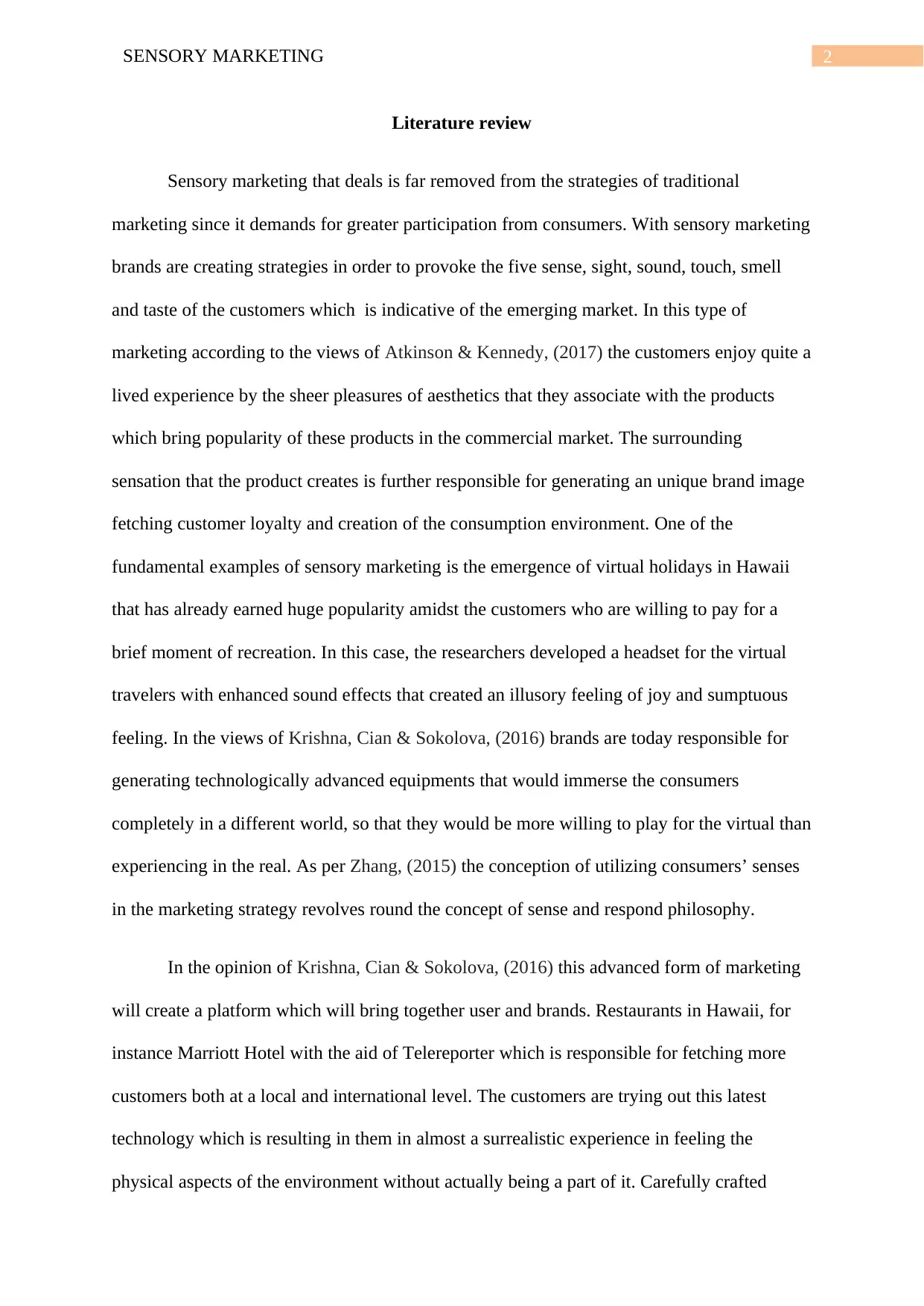
2SENSORY MARKETING
Literature review
Sensory marketing that deals is far removed from the strategies of traditional
marketing since it demands for greater participation from consumers. With sensory marketing
brands are creating strategies in order to provoke the five sense, sight, sound, touch, smell
and taste of the customers which is indicative of the emerging market. In this type of
marketing according to the views of Atkinson & Kennedy, (2017) the customers enjoy quite a
lived experience by the sheer pleasures of aesthetics that they associate with the products
which bring popularity of these products in the commercial market. The surrounding
sensation that the product creates is further responsible for generating an unique brand image
fetching customer loyalty and creation of the consumption environment. One of the
fundamental examples of sensory marketing is the emergence of virtual holidays in Hawaii
that has already earned huge popularity amidst the customers who are willing to pay for a
brief moment of recreation. In this case, the researchers developed a headset for the virtual
travelers with enhanced sound effects that created an illusory feeling of joy and sumptuous
feeling. In the views of Krishna, Cian & Sokolova, (2016) brands are today responsible for
generating technologically advanced equipments that would immerse the consumers
completely in a different world, so that they would be more willing to play for the virtual than
experiencing in the real. As per Zhang, (2015) the conception of utilizing consumers’ senses
in the marketing strategy revolves round the concept of sense and respond philosophy.
In the opinion of Krishna, Cian & Sokolova, (2016) this advanced form of marketing
will create a platform which will bring together user and brands. Restaurants in Hawaii, for
instance Marriott Hotel with the aid of Telereporter which is responsible for fetching more
customers both at a local and international level. The customers are trying out this latest
technology which is resulting in them in almost a surrealistic experience in feeling the
physical aspects of the environment without actually being a part of it. Carefully crafted
Literature review
Sensory marketing that deals is far removed from the strategies of traditional
marketing since it demands for greater participation from consumers. With sensory marketing
brands are creating strategies in order to provoke the five sense, sight, sound, touch, smell
and taste of the customers which is indicative of the emerging market. In this type of
marketing according to the views of Atkinson & Kennedy, (2017) the customers enjoy quite a
lived experience by the sheer pleasures of aesthetics that they associate with the products
which bring popularity of these products in the commercial market. The surrounding
sensation that the product creates is further responsible for generating an unique brand image
fetching customer loyalty and creation of the consumption environment. One of the
fundamental examples of sensory marketing is the emergence of virtual holidays in Hawaii
that has already earned huge popularity amidst the customers who are willing to pay for a
brief moment of recreation. In this case, the researchers developed a headset for the virtual
travelers with enhanced sound effects that created an illusory feeling of joy and sumptuous
feeling. In the views of Krishna, Cian & Sokolova, (2016) brands are today responsible for
generating technologically advanced equipments that would immerse the consumers
completely in a different world, so that they would be more willing to play for the virtual than
experiencing in the real. As per Zhang, (2015) the conception of utilizing consumers’ senses
in the marketing strategy revolves round the concept of sense and respond philosophy.
In the opinion of Krishna, Cian & Sokolova, (2016) this advanced form of marketing
will create a platform which will bring together user and brands. Restaurants in Hawaii, for
instance Marriott Hotel with the aid of Telereporter which is responsible for fetching more
customers both at a local and international level. The customers are trying out this latest
technology which is resulting in them in almost a surrealistic experience in feeling the
physical aspects of the environment without actually being a part of it. Carefully crafted
⊘ This is a preview!⊘
Do you want full access?
Subscribe today to unlock all pages.

Trusted by 1+ million students worldwide
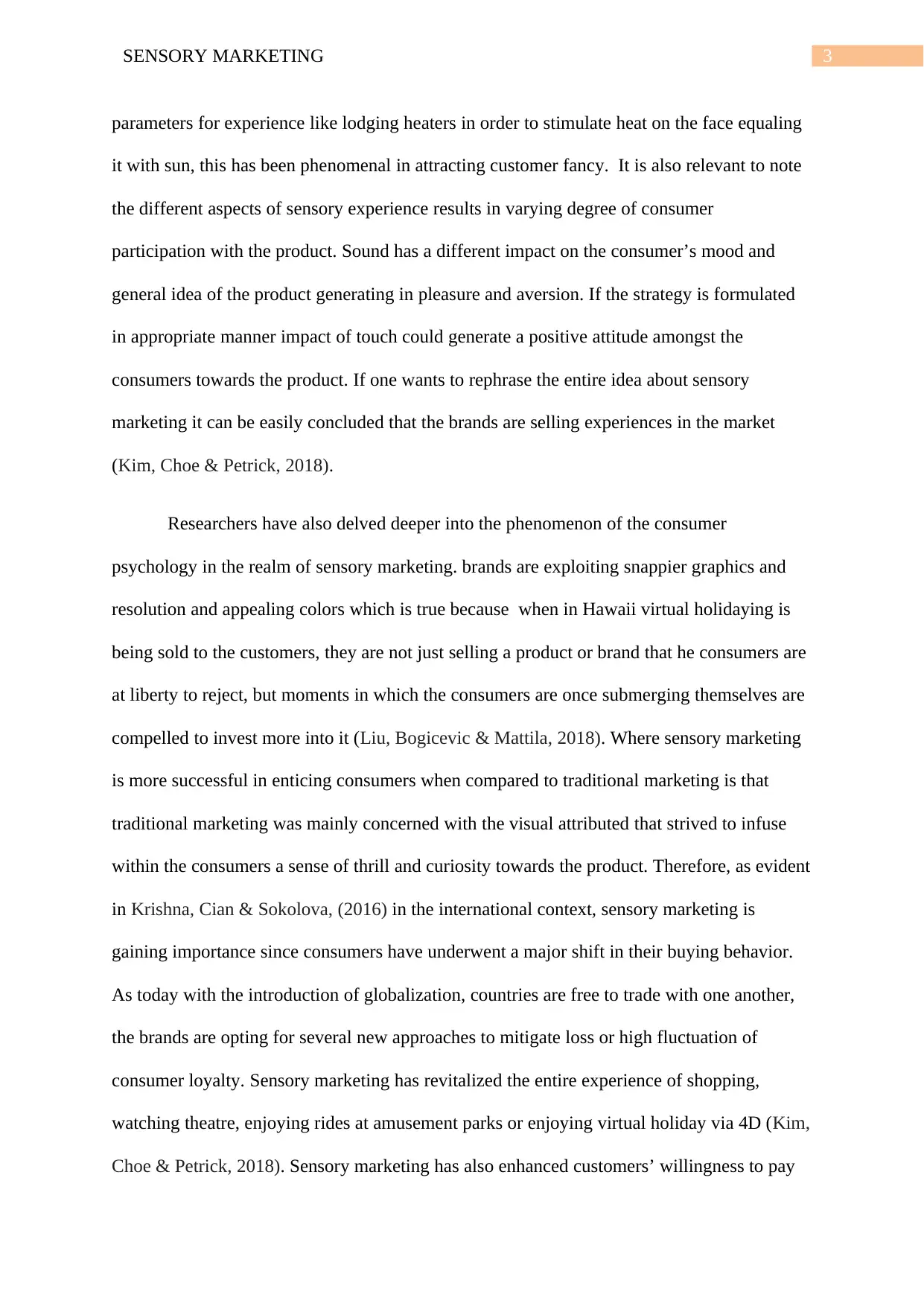
3SENSORY MARKETING
parameters for experience like lodging heaters in order to stimulate heat on the face equaling
it with sun, this has been phenomenal in attracting customer fancy. It is also relevant to note
the different aspects of sensory experience results in varying degree of consumer
participation with the product. Sound has a different impact on the consumer’s mood and
general idea of the product generating in pleasure and aversion. If the strategy is formulated
in appropriate manner impact of touch could generate a positive attitude amongst the
consumers towards the product. If one wants to rephrase the entire idea about sensory
marketing it can be easily concluded that the brands are selling experiences in the market
(Kim, Choe & Petrick, 2018).
Researchers have also delved deeper into the phenomenon of the consumer
psychology in the realm of sensory marketing. brands are exploiting snappier graphics and
resolution and appealing colors which is true because when in Hawaii virtual holidaying is
being sold to the customers, they are not just selling a product or brand that he consumers are
at liberty to reject, but moments in which the consumers are once submerging themselves are
compelled to invest more into it (Liu, Bogicevic & Mattila, 2018). Where sensory marketing
is more successful in enticing consumers when compared to traditional marketing is that
traditional marketing was mainly concerned with the visual attributed that strived to infuse
within the consumers a sense of thrill and curiosity towards the product. Therefore, as evident
in Krishna, Cian & Sokolova, (2016) in the international context, sensory marketing is
gaining importance since consumers have underwent a major shift in their buying behavior.
As today with the introduction of globalization, countries are free to trade with one another,
the brands are opting for several new approaches to mitigate loss or high fluctuation of
consumer loyalty. Sensory marketing has revitalized the entire experience of shopping,
watching theatre, enjoying rides at amusement parks or enjoying virtual holiday via 4D (Kim,
Choe & Petrick, 2018). Sensory marketing has also enhanced customers’ willingness to pay
parameters for experience like lodging heaters in order to stimulate heat on the face equaling
it with sun, this has been phenomenal in attracting customer fancy. It is also relevant to note
the different aspects of sensory experience results in varying degree of consumer
participation with the product. Sound has a different impact on the consumer’s mood and
general idea of the product generating in pleasure and aversion. If the strategy is formulated
in appropriate manner impact of touch could generate a positive attitude amongst the
consumers towards the product. If one wants to rephrase the entire idea about sensory
marketing it can be easily concluded that the brands are selling experiences in the market
(Kim, Choe & Petrick, 2018).
Researchers have also delved deeper into the phenomenon of the consumer
psychology in the realm of sensory marketing. brands are exploiting snappier graphics and
resolution and appealing colors which is true because when in Hawaii virtual holidaying is
being sold to the customers, they are not just selling a product or brand that he consumers are
at liberty to reject, but moments in which the consumers are once submerging themselves are
compelled to invest more into it (Liu, Bogicevic & Mattila, 2018). Where sensory marketing
is more successful in enticing consumers when compared to traditional marketing is that
traditional marketing was mainly concerned with the visual attributed that strived to infuse
within the consumers a sense of thrill and curiosity towards the product. Therefore, as evident
in Krishna, Cian & Sokolova, (2016) in the international context, sensory marketing is
gaining importance since consumers have underwent a major shift in their buying behavior.
As today with the introduction of globalization, countries are free to trade with one another,
the brands are opting for several new approaches to mitigate loss or high fluctuation of
consumer loyalty. Sensory marketing has revitalized the entire experience of shopping,
watching theatre, enjoying rides at amusement parks or enjoying virtual holiday via 4D (Kim,
Choe & Petrick, 2018). Sensory marketing has also enhanced customers’ willingness to pay
Paraphrase This Document
Need a fresh take? Get an instant paraphrase of this document with our AI Paraphraser
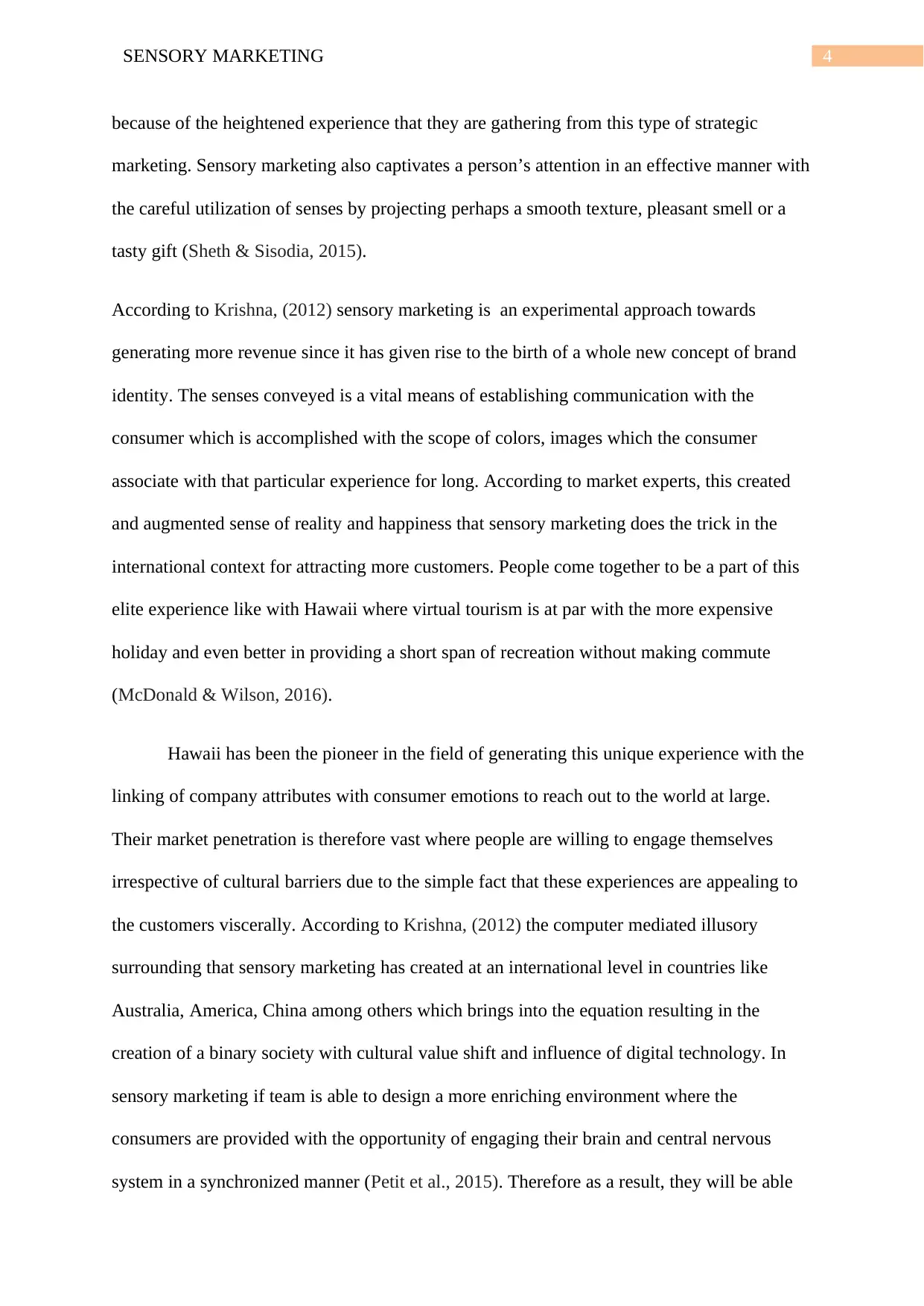
4SENSORY MARKETING
because of the heightened experience that they are gathering from this type of strategic
marketing. Sensory marketing also captivates a person’s attention in an effective manner with
the careful utilization of senses by projecting perhaps a smooth texture, pleasant smell or a
tasty gift (Sheth & Sisodia, 2015).
According to Krishna, (2012) sensory marketing is an experimental approach towards
generating more revenue since it has given rise to the birth of a whole new concept of brand
identity. The senses conveyed is a vital means of establishing communication with the
consumer which is accomplished with the scope of colors, images which the consumer
associate with that particular experience for long. According to market experts, this created
and augmented sense of reality and happiness that sensory marketing does the trick in the
international context for attracting more customers. People come together to be a part of this
elite experience like with Hawaii where virtual tourism is at par with the more expensive
holiday and even better in providing a short span of recreation without making commute
(McDonald & Wilson, 2016).
Hawaii has been the pioneer in the field of generating this unique experience with the
linking of company attributes with consumer emotions to reach out to the world at large.
Their market penetration is therefore vast where people are willing to engage themselves
irrespective of cultural barriers due to the simple fact that these experiences are appealing to
the customers viscerally. According to Krishna, (2012) the computer mediated illusory
surrounding that sensory marketing has created at an international level in countries like
Australia, America, China among others which brings into the equation resulting in the
creation of a binary society with cultural value shift and influence of digital technology. In
sensory marketing if team is able to design a more enriching environment where the
consumers are provided with the opportunity of engaging their brain and central nervous
system in a synchronized manner (Petit et al., 2015). Therefore as a result, they will be able
because of the heightened experience that they are gathering from this type of strategic
marketing. Sensory marketing also captivates a person’s attention in an effective manner with
the careful utilization of senses by projecting perhaps a smooth texture, pleasant smell or a
tasty gift (Sheth & Sisodia, 2015).
According to Krishna, (2012) sensory marketing is an experimental approach towards
generating more revenue since it has given rise to the birth of a whole new concept of brand
identity. The senses conveyed is a vital means of establishing communication with the
consumer which is accomplished with the scope of colors, images which the consumer
associate with that particular experience for long. According to market experts, this created
and augmented sense of reality and happiness that sensory marketing does the trick in the
international context for attracting more customers. People come together to be a part of this
elite experience like with Hawaii where virtual tourism is at par with the more expensive
holiday and even better in providing a short span of recreation without making commute
(McDonald & Wilson, 2016).
Hawaii has been the pioneer in the field of generating this unique experience with the
linking of company attributes with consumer emotions to reach out to the world at large.
Their market penetration is therefore vast where people are willing to engage themselves
irrespective of cultural barriers due to the simple fact that these experiences are appealing to
the customers viscerally. According to Krishna, (2012) the computer mediated illusory
surrounding that sensory marketing has created at an international level in countries like
Australia, America, China among others which brings into the equation resulting in the
creation of a binary society with cultural value shift and influence of digital technology. In
sensory marketing if team is able to design a more enriching environment where the
consumers are provided with the opportunity of engaging their brain and central nervous
system in a synchronized manner (Petit et al., 2015). Therefore as a result, they will be able
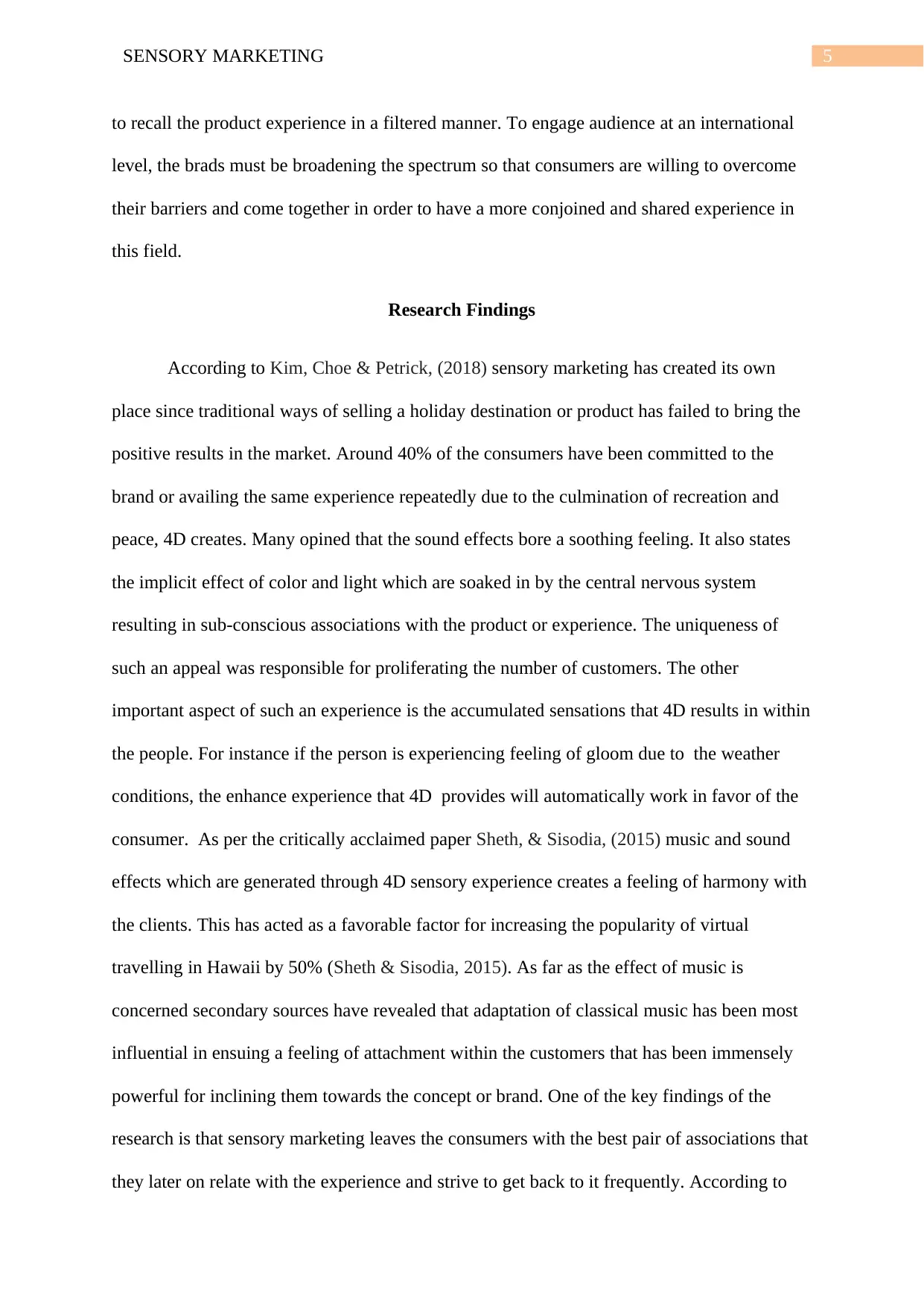
5SENSORY MARKETING
to recall the product experience in a filtered manner. To engage audience at an international
level, the brads must be broadening the spectrum so that consumers are willing to overcome
their barriers and come together in order to have a more conjoined and shared experience in
this field.
Research Findings
According to Kim, Choe & Petrick, (2018) sensory marketing has created its own
place since traditional ways of selling a holiday destination or product has failed to bring the
positive results in the market. Around 40% of the consumers have been committed to the
brand or availing the same experience repeatedly due to the culmination of recreation and
peace, 4D creates. Many opined that the sound effects bore a soothing feeling. It also states
the implicit effect of color and light which are soaked in by the central nervous system
resulting in sub-conscious associations with the product or experience. The uniqueness of
such an appeal was responsible for proliferating the number of customers. The other
important aspect of such an experience is the accumulated sensations that 4D results in within
the people. For instance if the person is experiencing feeling of gloom due to the weather
conditions, the enhance experience that 4D provides will automatically work in favor of the
consumer. As per the critically acclaimed paper Sheth, & Sisodia, (2015) music and sound
effects which are generated through 4D sensory experience creates a feeling of harmony with
the clients. This has acted as a favorable factor for increasing the popularity of virtual
travelling in Hawaii by 50% (Sheth & Sisodia, 2015). As far as the effect of music is
concerned secondary sources have revealed that adaptation of classical music has been most
influential in ensuing a feeling of attachment within the customers that has been immensely
powerful for inclining them towards the concept or brand. One of the key findings of the
research is that sensory marketing leaves the consumers with the best pair of associations that
they later on relate with the experience and strive to get back to it frequently. According to
to recall the product experience in a filtered manner. To engage audience at an international
level, the brads must be broadening the spectrum so that consumers are willing to overcome
their barriers and come together in order to have a more conjoined and shared experience in
this field.
Research Findings
According to Kim, Choe & Petrick, (2018) sensory marketing has created its own
place since traditional ways of selling a holiday destination or product has failed to bring the
positive results in the market. Around 40% of the consumers have been committed to the
brand or availing the same experience repeatedly due to the culmination of recreation and
peace, 4D creates. Many opined that the sound effects bore a soothing feeling. It also states
the implicit effect of color and light which are soaked in by the central nervous system
resulting in sub-conscious associations with the product or experience. The uniqueness of
such an appeal was responsible for proliferating the number of customers. The other
important aspect of such an experience is the accumulated sensations that 4D results in within
the people. For instance if the person is experiencing feeling of gloom due to the weather
conditions, the enhance experience that 4D provides will automatically work in favor of the
consumer. As per the critically acclaimed paper Sheth, & Sisodia, (2015) music and sound
effects which are generated through 4D sensory experience creates a feeling of harmony with
the clients. This has acted as a favorable factor for increasing the popularity of virtual
travelling in Hawaii by 50% (Sheth & Sisodia, 2015). As far as the effect of music is
concerned secondary sources have revealed that adaptation of classical music has been most
influential in ensuing a feeling of attachment within the customers that has been immensely
powerful for inclining them towards the concept or brand. One of the key findings of the
research is that sensory marketing leaves the consumers with the best pair of associations that
they later on relate with the experience and strive to get back to it frequently. According to
⊘ This is a preview!⊘
Do you want full access?
Subscribe today to unlock all pages.

Trusted by 1+ million students worldwide
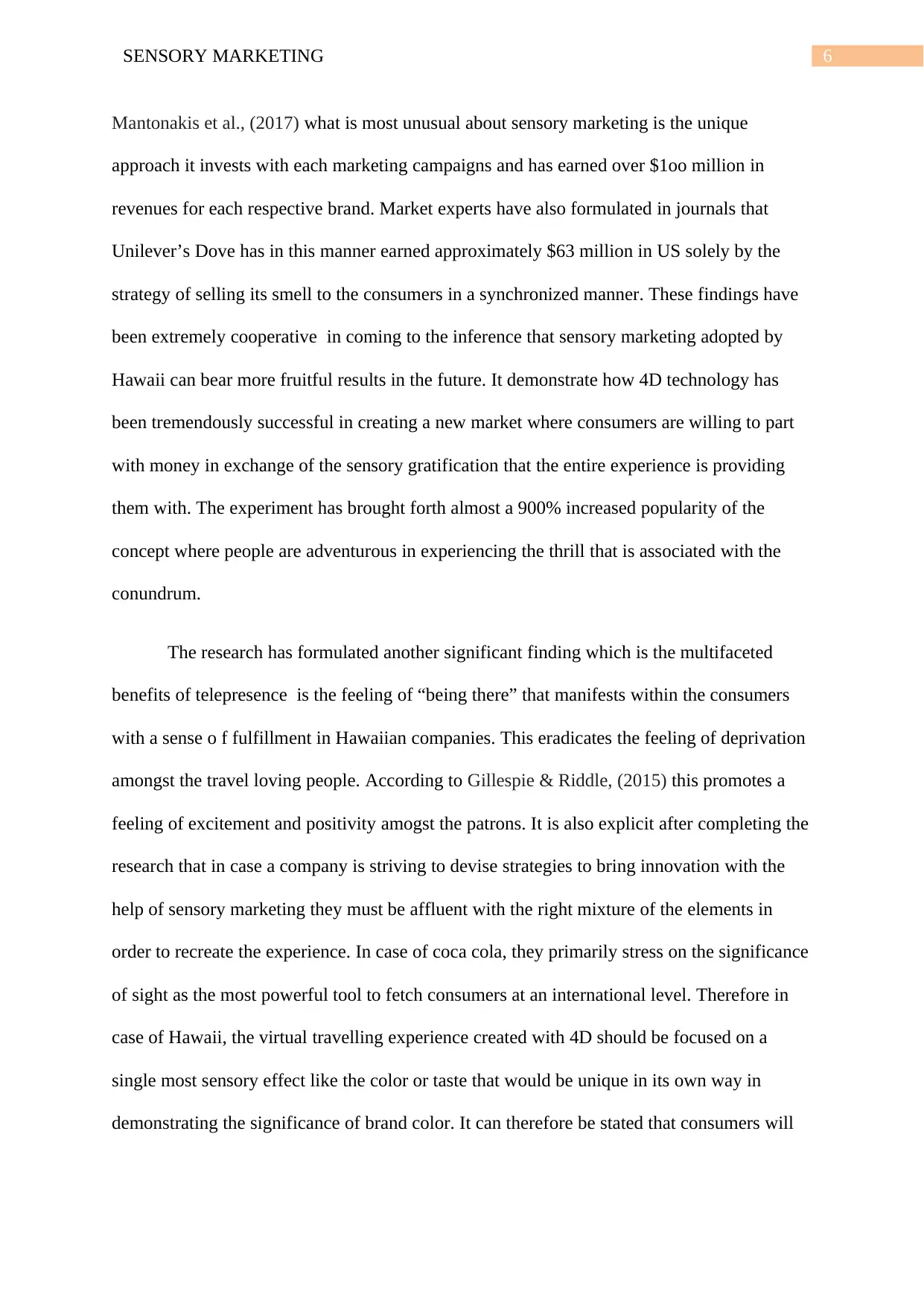
6SENSORY MARKETING
Mantonakis et al., (2017) what is most unusual about sensory marketing is the unique
approach it invests with each marketing campaigns and has earned over $1oo million in
revenues for each respective brand. Market experts have also formulated in journals that
Unilever’s Dove has in this manner earned approximately $63 million in US solely by the
strategy of selling its smell to the consumers in a synchronized manner. These findings have
been extremely cooperative in coming to the inference that sensory marketing adopted by
Hawaii can bear more fruitful results in the future. It demonstrate how 4D technology has
been tremendously successful in creating a new market where consumers are willing to part
with money in exchange of the sensory gratification that the entire experience is providing
them with. The experiment has brought forth almost a 900% increased popularity of the
concept where people are adventurous in experiencing the thrill that is associated with the
conundrum.
The research has formulated another significant finding which is the multifaceted
benefits of telepresence is the feeling of “being there” that manifests within the consumers
with a sense o f fulfillment in Hawaiian companies. This eradicates the feeling of deprivation
amongst the travel loving people. According to Gillespie & Riddle, (2015) this promotes a
feeling of excitement and positivity amogst the patrons. It is also explicit after completing the
research that in case a company is striving to devise strategies to bring innovation with the
help of sensory marketing they must be affluent with the right mixture of the elements in
order to recreate the experience. In case of coca cola, they primarily stress on the significance
of sight as the most powerful tool to fetch consumers at an international level. Therefore in
case of Hawaii, the virtual travelling experience created with 4D should be focused on a
single most sensory effect like the color or taste that would be unique in its own way in
demonstrating the significance of brand color. It can therefore be stated that consumers will
Mantonakis et al., (2017) what is most unusual about sensory marketing is the unique
approach it invests with each marketing campaigns and has earned over $1oo million in
revenues for each respective brand. Market experts have also formulated in journals that
Unilever’s Dove has in this manner earned approximately $63 million in US solely by the
strategy of selling its smell to the consumers in a synchronized manner. These findings have
been extremely cooperative in coming to the inference that sensory marketing adopted by
Hawaii can bear more fruitful results in the future. It demonstrate how 4D technology has
been tremendously successful in creating a new market where consumers are willing to part
with money in exchange of the sensory gratification that the entire experience is providing
them with. The experiment has brought forth almost a 900% increased popularity of the
concept where people are adventurous in experiencing the thrill that is associated with the
conundrum.
The research has formulated another significant finding which is the multifaceted
benefits of telepresence is the feeling of “being there” that manifests within the consumers
with a sense o f fulfillment in Hawaiian companies. This eradicates the feeling of deprivation
amongst the travel loving people. According to Gillespie & Riddle, (2015) this promotes a
feeling of excitement and positivity amogst the patrons. It is also explicit after completing the
research that in case a company is striving to devise strategies to bring innovation with the
help of sensory marketing they must be affluent with the right mixture of the elements in
order to recreate the experience. In case of coca cola, they primarily stress on the significance
of sight as the most powerful tool to fetch consumers at an international level. Therefore in
case of Hawaii, the virtual travelling experience created with 4D should be focused on a
single most sensory effect like the color or taste that would be unique in its own way in
demonstrating the significance of brand color. It can therefore be stated that consumers will
Paraphrase This Document
Need a fresh take? Get an instant paraphrase of this document with our AI Paraphraser
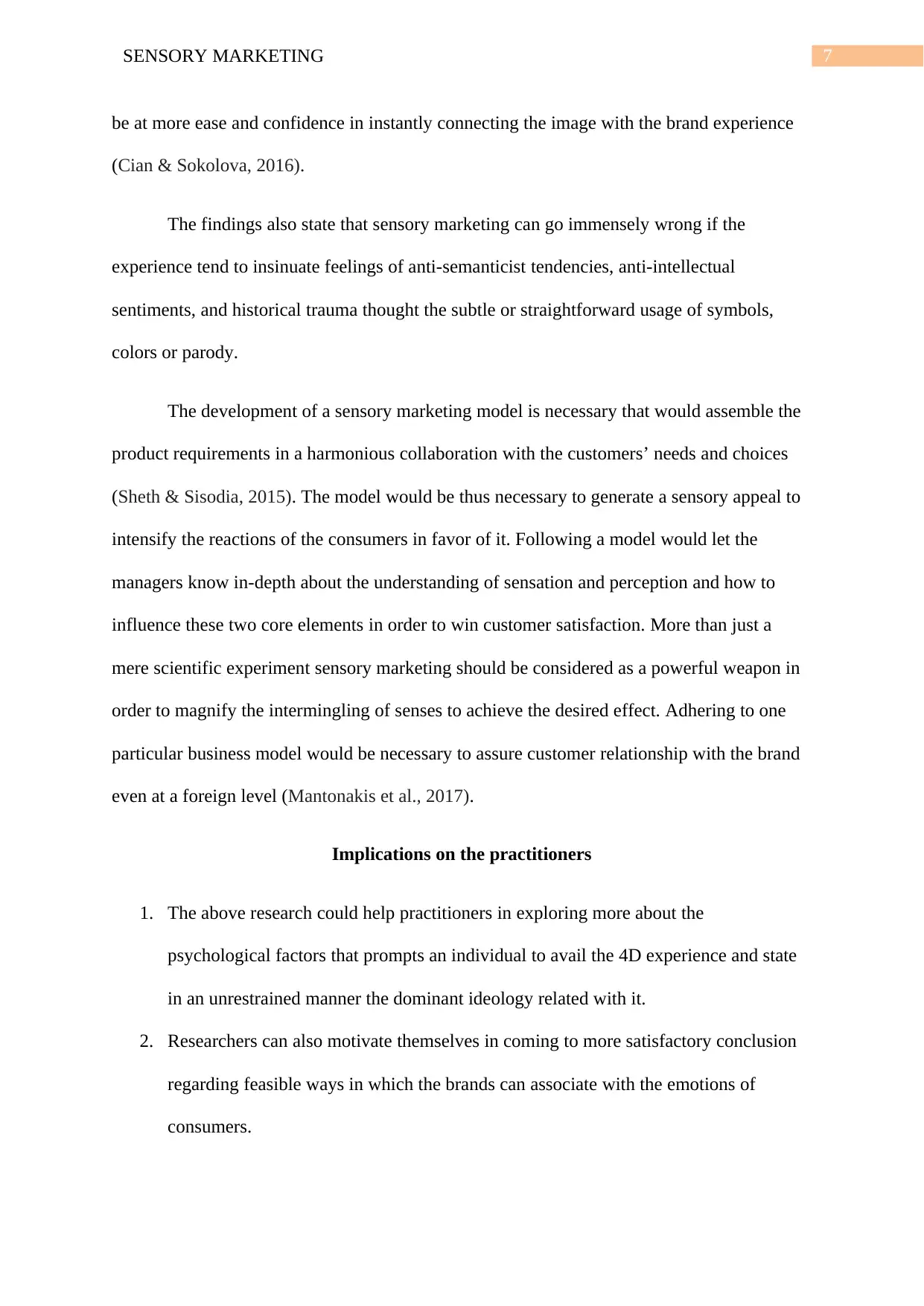
7SENSORY MARKETING
be at more ease and confidence in instantly connecting the image with the brand experience
(Cian & Sokolova, 2016).
The findings also state that sensory marketing can go immensely wrong if the
experience tend to insinuate feelings of anti-semanticist tendencies, anti-intellectual
sentiments, and historical trauma thought the subtle or straightforward usage of symbols,
colors or parody.
The development of a sensory marketing model is necessary that would assemble the
product requirements in a harmonious collaboration with the customers’ needs and choices
(Sheth & Sisodia, 2015). The model would be thus necessary to generate a sensory appeal to
intensify the reactions of the consumers in favor of it. Following a model would let the
managers know in-depth about the understanding of sensation and perception and how to
influence these two core elements in order to win customer satisfaction. More than just a
mere scientific experiment sensory marketing should be considered as a powerful weapon in
order to magnify the intermingling of senses to achieve the desired effect. Adhering to one
particular business model would be necessary to assure customer relationship with the brand
even at a foreign level (Mantonakis et al., 2017).
Implications on the practitioners
1. The above research could help practitioners in exploring more about the
psychological factors that prompts an individual to avail the 4D experience and state
in an unrestrained manner the dominant ideology related with it.
2. Researchers can also motivate themselves in coming to more satisfactory conclusion
regarding feasible ways in which the brands can associate with the emotions of
consumers.
be at more ease and confidence in instantly connecting the image with the brand experience
(Cian & Sokolova, 2016).
The findings also state that sensory marketing can go immensely wrong if the
experience tend to insinuate feelings of anti-semanticist tendencies, anti-intellectual
sentiments, and historical trauma thought the subtle or straightforward usage of symbols,
colors or parody.
The development of a sensory marketing model is necessary that would assemble the
product requirements in a harmonious collaboration with the customers’ needs and choices
(Sheth & Sisodia, 2015). The model would be thus necessary to generate a sensory appeal to
intensify the reactions of the consumers in favor of it. Following a model would let the
managers know in-depth about the understanding of sensation and perception and how to
influence these two core elements in order to win customer satisfaction. More than just a
mere scientific experiment sensory marketing should be considered as a powerful weapon in
order to magnify the intermingling of senses to achieve the desired effect. Adhering to one
particular business model would be necessary to assure customer relationship with the brand
even at a foreign level (Mantonakis et al., 2017).
Implications on the practitioners
1. The above research could help practitioners in exploring more about the
psychological factors that prompts an individual to avail the 4D experience and state
in an unrestrained manner the dominant ideology related with it.
2. Researchers can also motivate themselves in coming to more satisfactory conclusion
regarding feasible ways in which the brands can associate with the emotions of
consumers.
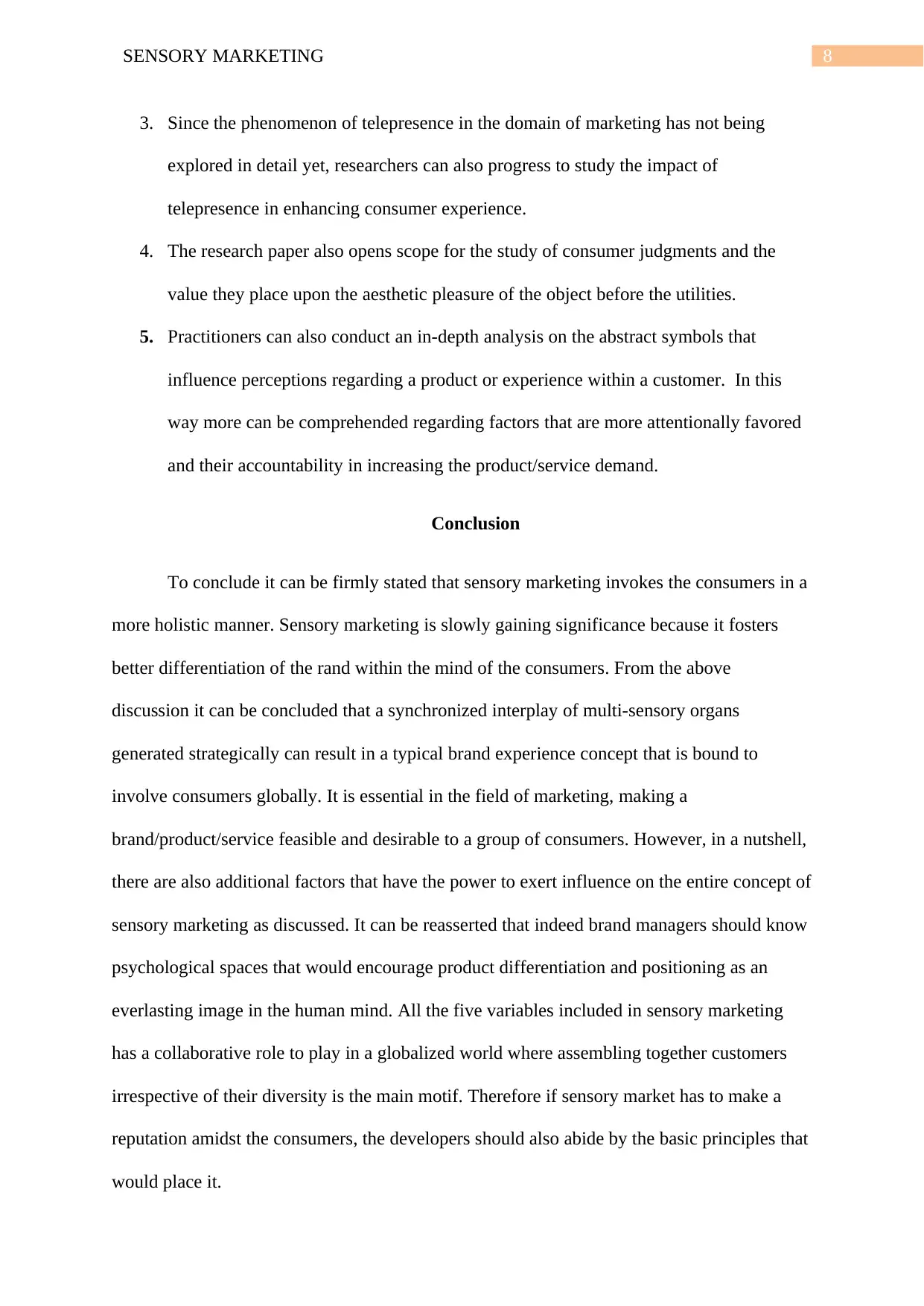
8SENSORY MARKETING
3. Since the phenomenon of telepresence in the domain of marketing has not being
explored in detail yet, researchers can also progress to study the impact of
telepresence in enhancing consumer experience.
4. The research paper also opens scope for the study of consumer judgments and the
value they place upon the aesthetic pleasure of the object before the utilities.
5. Practitioners can also conduct an in-depth analysis on the abstract symbols that
influence perceptions regarding a product or experience within a customer. In this
way more can be comprehended regarding factors that are more attentionally favored
and their accountability in increasing the product/service demand.
Conclusion
To conclude it can be firmly stated that sensory marketing invokes the consumers in a
more holistic manner. Sensory marketing is slowly gaining significance because it fosters
better differentiation of the rand within the mind of the consumers. From the above
discussion it can be concluded that a synchronized interplay of multi-sensory organs
generated strategically can result in a typical brand experience concept that is bound to
involve consumers globally. It is essential in the field of marketing, making a
brand/product/service feasible and desirable to a group of consumers. However, in a nutshell,
there are also additional factors that have the power to exert influence on the entire concept of
sensory marketing as discussed. It can be reasserted that indeed brand managers should know
psychological spaces that would encourage product differentiation and positioning as an
everlasting image in the human mind. All the five variables included in sensory marketing
has a collaborative role to play in a globalized world where assembling together customers
irrespective of their diversity is the main motif. Therefore if sensory market has to make a
reputation amidst the consumers, the developers should also abide by the basic principles that
would place it.
3. Since the phenomenon of telepresence in the domain of marketing has not being
explored in detail yet, researchers can also progress to study the impact of
telepresence in enhancing consumer experience.
4. The research paper also opens scope for the study of consumer judgments and the
value they place upon the aesthetic pleasure of the object before the utilities.
5. Practitioners can also conduct an in-depth analysis on the abstract symbols that
influence perceptions regarding a product or experience within a customer. In this
way more can be comprehended regarding factors that are more attentionally favored
and their accountability in increasing the product/service demand.
Conclusion
To conclude it can be firmly stated that sensory marketing invokes the consumers in a
more holistic manner. Sensory marketing is slowly gaining significance because it fosters
better differentiation of the rand within the mind of the consumers. From the above
discussion it can be concluded that a synchronized interplay of multi-sensory organs
generated strategically can result in a typical brand experience concept that is bound to
involve consumers globally. It is essential in the field of marketing, making a
brand/product/service feasible and desirable to a group of consumers. However, in a nutshell,
there are also additional factors that have the power to exert influence on the entire concept of
sensory marketing as discussed. It can be reasserted that indeed brand managers should know
psychological spaces that would encourage product differentiation and positioning as an
everlasting image in the human mind. All the five variables included in sensory marketing
has a collaborative role to play in a globalized world where assembling together customers
irrespective of their diversity is the main motif. Therefore if sensory market has to make a
reputation amidst the consumers, the developers should also abide by the basic principles that
would place it.
⊘ This is a preview!⊘
Do you want full access?
Subscribe today to unlock all pages.

Trusted by 1+ million students worldwide

9SENSORY MARKETING
Paraphrase This Document
Need a fresh take? Get an instant paraphrase of this document with our AI Paraphraser
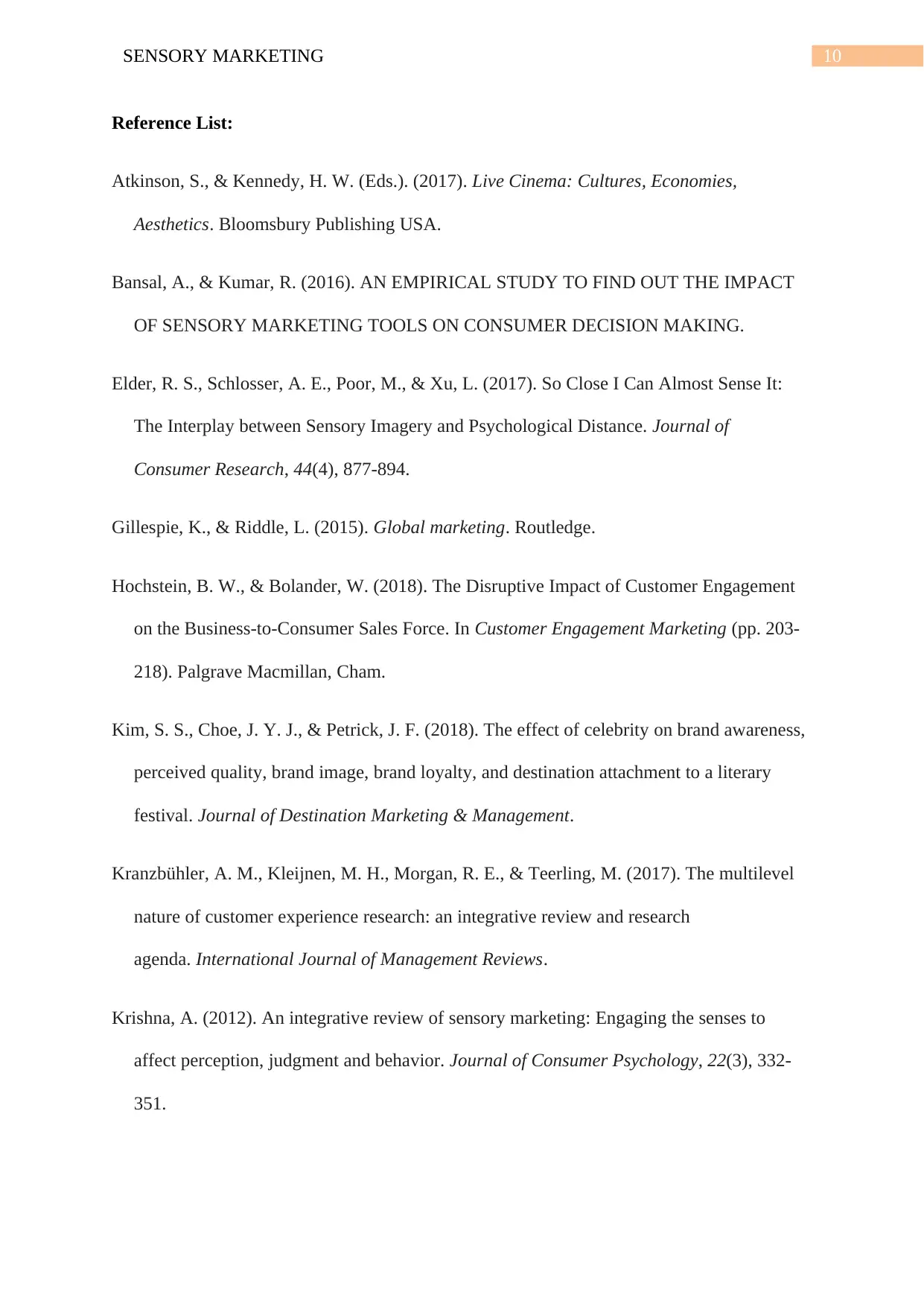
10SENSORY MARKETING
Reference List:
Atkinson, S., & Kennedy, H. W. (Eds.). (2017). Live Cinema: Cultures, Economies,
Aesthetics. Bloomsbury Publishing USA.
Bansal, A., & Kumar, R. (2016). AN EMPIRICAL STUDY TO FIND OUT THE IMPACT
OF SENSORY MARKETING TOOLS ON CONSUMER DECISION MAKING.
Elder, R. S., Schlosser, A. E., Poor, M., & Xu, L. (2017). So Close I Can Almost Sense It:
The Interplay between Sensory Imagery and Psychological Distance. Journal of
Consumer Research, 44(4), 877-894.
Gillespie, K., & Riddle, L. (2015). Global marketing. Routledge.
Hochstein, B. W., & Bolander, W. (2018). The Disruptive Impact of Customer Engagement
on the Business-to-Consumer Sales Force. In Customer Engagement Marketing (pp. 203-
218). Palgrave Macmillan, Cham.
Kim, S. S., Choe, J. Y. J., & Petrick, J. F. (2018). The effect of celebrity on brand awareness,
perceived quality, brand image, brand loyalty, and destination attachment to a literary
festival. Journal of Destination Marketing & Management.
Kranzbühler, A. M., Kleijnen, M. H., Morgan, R. E., & Teerling, M. (2017). The multilevel
nature of customer experience research: an integrative review and research
agenda. International Journal of Management Reviews.
Krishna, A. (2012). An integrative review of sensory marketing: Engaging the senses to
affect perception, judgment and behavior. Journal of Consumer Psychology, 22(3), 332-
351.
Reference List:
Atkinson, S., & Kennedy, H. W. (Eds.). (2017). Live Cinema: Cultures, Economies,
Aesthetics. Bloomsbury Publishing USA.
Bansal, A., & Kumar, R. (2016). AN EMPIRICAL STUDY TO FIND OUT THE IMPACT
OF SENSORY MARKETING TOOLS ON CONSUMER DECISION MAKING.
Elder, R. S., Schlosser, A. E., Poor, M., & Xu, L. (2017). So Close I Can Almost Sense It:
The Interplay between Sensory Imagery and Psychological Distance. Journal of
Consumer Research, 44(4), 877-894.
Gillespie, K., & Riddle, L. (2015). Global marketing. Routledge.
Hochstein, B. W., & Bolander, W. (2018). The Disruptive Impact of Customer Engagement
on the Business-to-Consumer Sales Force. In Customer Engagement Marketing (pp. 203-
218). Palgrave Macmillan, Cham.
Kim, S. S., Choe, J. Y. J., & Petrick, J. F. (2018). The effect of celebrity on brand awareness,
perceived quality, brand image, brand loyalty, and destination attachment to a literary
festival. Journal of Destination Marketing & Management.
Kranzbühler, A. M., Kleijnen, M. H., Morgan, R. E., & Teerling, M. (2017). The multilevel
nature of customer experience research: an integrative review and research
agenda. International Journal of Management Reviews.
Krishna, A. (2012). An integrative review of sensory marketing: Engaging the senses to
affect perception, judgment and behavior. Journal of Consumer Psychology, 22(3), 332-
351.
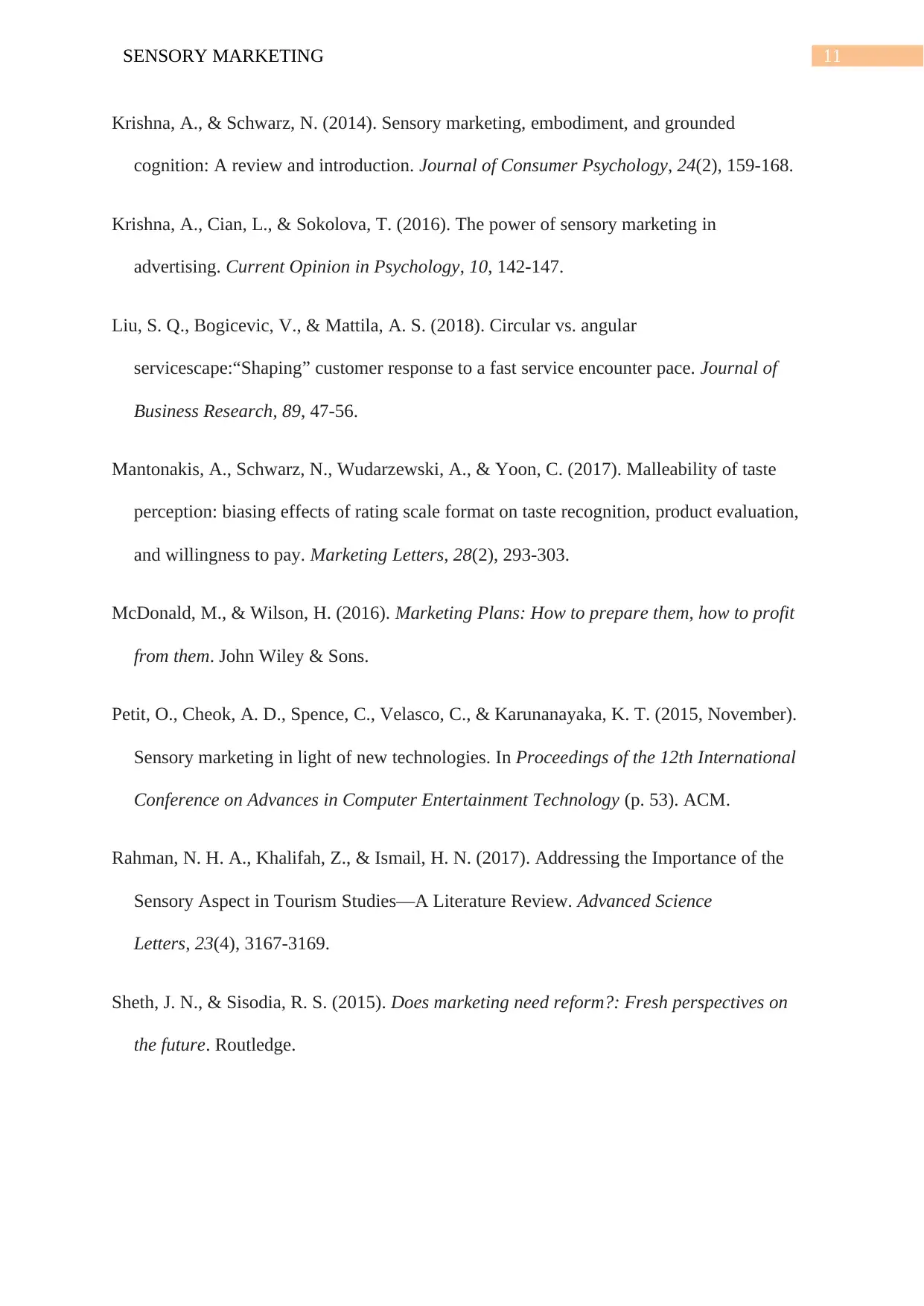
11SENSORY MARKETING
Krishna, A., & Schwarz, N. (2014). Sensory marketing, embodiment, and grounded
cognition: A review and introduction. Journal of Consumer Psychology, 24(2), 159-168.
Krishna, A., Cian, L., & Sokolova, T. (2016). The power of sensory marketing in
advertising. Current Opinion in Psychology, 10, 142-147.
Liu, S. Q., Bogicevic, V., & Mattila, A. S. (2018). Circular vs. angular
servicescape:“Shaping” customer response to a fast service encounter pace. Journal of
Business Research, 89, 47-56.
Mantonakis, A., Schwarz, N., Wudarzewski, A., & Yoon, C. (2017). Malleability of taste
perception: biasing effects of rating scale format on taste recognition, product evaluation,
and willingness to pay. Marketing Letters, 28(2), 293-303.
McDonald, M., & Wilson, H. (2016). Marketing Plans: How to prepare them, how to profit
from them. John Wiley & Sons.
Petit, O., Cheok, A. D., Spence, C., Velasco, C., & Karunanayaka, K. T. (2015, November).
Sensory marketing in light of new technologies. In Proceedings of the 12th International
Conference on Advances in Computer Entertainment Technology (p. 53). ACM.
Rahman, N. H. A., Khalifah, Z., & Ismail, H. N. (2017). Addressing the Importance of the
Sensory Aspect in Tourism Studies—A Literature Review. Advanced Science
Letters, 23(4), 3167-3169.
Sheth, J. N., & Sisodia, R. S. (2015). Does marketing need reform?: Fresh perspectives on
the future. Routledge.
Krishna, A., & Schwarz, N. (2014). Sensory marketing, embodiment, and grounded
cognition: A review and introduction. Journal of Consumer Psychology, 24(2), 159-168.
Krishna, A., Cian, L., & Sokolova, T. (2016). The power of sensory marketing in
advertising. Current Opinion in Psychology, 10, 142-147.
Liu, S. Q., Bogicevic, V., & Mattila, A. S. (2018). Circular vs. angular
servicescape:“Shaping” customer response to a fast service encounter pace. Journal of
Business Research, 89, 47-56.
Mantonakis, A., Schwarz, N., Wudarzewski, A., & Yoon, C. (2017). Malleability of taste
perception: biasing effects of rating scale format on taste recognition, product evaluation,
and willingness to pay. Marketing Letters, 28(2), 293-303.
McDonald, M., & Wilson, H. (2016). Marketing Plans: How to prepare them, how to profit
from them. John Wiley & Sons.
Petit, O., Cheok, A. D., Spence, C., Velasco, C., & Karunanayaka, K. T. (2015, November).
Sensory marketing in light of new technologies. In Proceedings of the 12th International
Conference on Advances in Computer Entertainment Technology (p. 53). ACM.
Rahman, N. H. A., Khalifah, Z., & Ismail, H. N. (2017). Addressing the Importance of the
Sensory Aspect in Tourism Studies—A Literature Review. Advanced Science
Letters, 23(4), 3167-3169.
Sheth, J. N., & Sisodia, R. S. (2015). Does marketing need reform?: Fresh perspectives on
the future. Routledge.
⊘ This is a preview!⊘
Do you want full access?
Subscribe today to unlock all pages.

Trusted by 1+ million students worldwide
1 out of 13
Related Documents
Your All-in-One AI-Powered Toolkit for Academic Success.
+13062052269
info@desklib.com
Available 24*7 on WhatsApp / Email
![[object Object]](/_next/static/media/star-bottom.7253800d.svg)
Unlock your academic potential
Copyright © 2020–2025 A2Z Services. All Rights Reserved. Developed and managed by ZUCOL.




